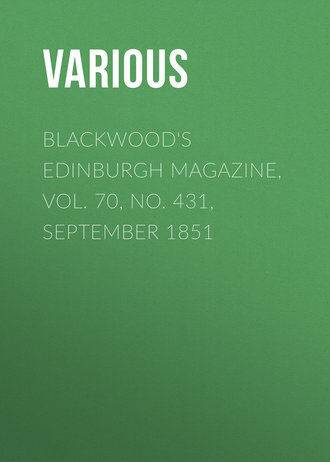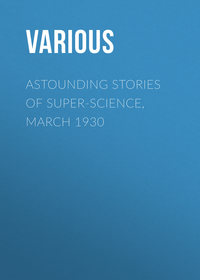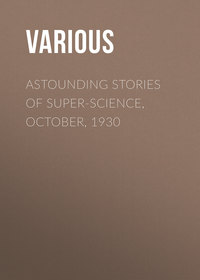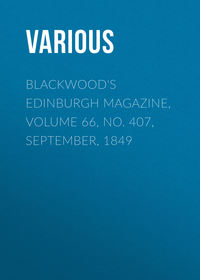 полная версия
полная версияПолная версия
Blackwood's Edinburgh Magazine, Vol. 70, No. 431, September 1851
It will be worth while to make, in passing, a single quotation from this pamphlet, Notes on the Construction of Sheepfolds. He tells us, in one place, that in the New Testament the ministers of the Church "are called, and call themselves, with absolute indifference, Deacons, Bishops, Elders, Evangelists, according to what they are doing at the time of speaking." With such a writer one might, at all events, have hoped to live in peace. But no. He discovers, nevertheless, that Episcopacy is the Scriptural form of Church government; and, having satisfied his own mind of this, no opposition or diversity of opinion is for a moment to be tolerated.
"But how," he says, "unite the two great sects of paralysed Protestants? By keeping simply to Scripture. The members of the Scottish Church have not a shadow of excuse for refusing Episcopacy: it has indeed been abused among them, grievously abused; but it is in the Bible, and that is all they have a right to ask.
"They have also no shadow of excuse for refusing to employ a written form of prayer. It may not be to their taste – it may not be the way in which they like to pray; but it is no question, at present, of likes or dislikes, but of duties; and the acceptance of such a form on their part would go half way to reconcile them with their brethren. Let them allege such objections as they can reasonably advance against the English form, and let these be carefully and humbly weighed by the pastors of both Churches: some of them ought to be at once forestalled. For the English Church, on the other hand, must," &c.
Into Mr Ruskin's own religious tenets, further than he has chosen to reveal them in his works, we have no wish to pry. But he must cease to be Mr Ruskin if they do not exhibit some salient peculiarity, coupled with a confidence, unusual even amongst zealots, that his peculiar views will speedily triumph. If he can be presumed to belong to any sect, it must be the last and smallest one amongst us – some sect as exclusive as German mysticism, with pretensions as great as those of the Church of Rome.
One word on the style of Mr Ruskin: it will save the trouble of alluding to it on particular occasions. It is very unequal. In both his architectural works he writes generally with great ease, spirit, and clearness. There is a racy vigour in the page. But when he would be very eloquent, as he is disposed to be in the Modern Painters, he becomes very verbose, tedious, obscure, extravagant. There is no discipline in his style, no moderation, no repose. Those qualities which he has known how to praise in art he has not aimed at in his own writing. A rank luxuriance of a semi-poetical diction lies about, perfectly unrestrained; metaphorical language comes before us in every species of disorder; and hyperbolical expressions are used till they become commonplace. Verbal criticism, he would probably look upon a very puerile business: he need fear nothing of the kind from us; we should as soon think of criticising or pruning a jungle. To add to the confusion, he appears at times to have proposed to himself the imitation of some of our older writers: pages are written in the rhythm of Jeremy Taylor; sometimes it is the venerable Hooker who seems to be his type; and he has even succeeded in combining whatever is most tedious and prolix in both these great writers. If the reader wishes a specimen of this sort of modern antique, he may turn to the fifteenth chapter of the second volume of the Modern Painters.
Coupled with this matter of style, and almost inseparable from it, is the violence of his manner on subjects which cannot possibly justify so vehement a zeal. We like a generous enthusiasm on any art – we delight in it; but who can travel in sympathy with a writer who exhausts on so much paint and canvass every term of rapture that the Alps themselves could have called forth? One need not be a utilitarian philosopher – or what Mr Ruskin describes as such – to smile at the lofty position on which he puts the landscape-painter, and the egregious and impossible demands he makes upon the art itself. And the condemnation and opprobrium with which he overwhelms the luckless artist who has offended him is quite as violent. The bough of a tree, "in the left hand upper corner" of a landscape of Poussin's, calls forth this terrible denunciation: —
"This latter is a representation of an ornamental group of elephants' tusks, with feathers tied to the ends of them. Not the wildest imagination could ever conjure up in it the remotest resemblance to the bough of a tree. It might be the claws of a witch – the talons of an eagle – the horns of a fiend; but it is a full assemblage of every conceivable falsehood which can be told respecting foliage – a piece of work so barbarous in every way that one glance at it ought to prove the complete charlatanism and trickery of the whole system of the old landscape-painters… I will say here at once, that such drawing as this is as ugly as it is childish, and as painful as it is false; and that the man who could tolerate, much more, who could deliberately set down such a thing on his canvass, had neither eye nor feeling for one single attribute or excellence of God's works. He might have drawn the other stem in excusable ignorance, or under some false impression of being able to improve upon nature, but this is conclusive and unpardonable." – (P. 382.)
The great redeeming quality of Mr Ruskin – and we wish to give it conspicuous and honourable mention – is his love of nature. Here lies the charm of his works; to this may be traced whatever virtue is in them, or whatever utility they may possess. They will send the painter more than ever to the study of nature, and perhaps they will have a still more beneficial effect on the art, by sending the critic of painting to the same school. It would be almost an insult to the landscape-painter to suppose that he needed this lesson; the very love of his art must lead him perpetually, one would think, to his great and delightful study amongst the fields, under the open skies, before the rivers and the hills. But the critic of the picture-gallery is often one who goes from picture to picture, and very little from nature to the painting. Consequently, where an artist succeeds in imitating some effect in nature which had not been before represented on the canvass, such a critic is more likely to be displeased than gratified; and the artist, having to paint for a conventional taste, is in danger of sacrificing to it his own higher aspirations. Now it is most true that no man should pretend to be a critic upon pictures unless he understands the art itself of painting; he ought, we suspect, to have handled the pencil or the brush himself; at all events, he ought in some way to have been initiated into the mysteries of the pallet and the easel. Otherwise, not knowing the difficulties to be overcome, nor the means at hand for encountering them, he cannot possibly estimate the degree of merit due to the artist for the production of this or that effect. He may be loud in applause where nothing has been displayed but the old traditions of the art. But still this is only one-half the knowledge he ought to possess. He ought to have studied nature, and to have loved the study, or he can never estimate, and never feel, that truth of effect which is the great aim of the artist. Mr Ruskin's works will help to shame out of the field all such half-informed and conventional criticism, the mere connoisseurship of the picture gallery. On the other hand, they will train men who have always been delighted spectators of nature to be also attentive observers. Our critics will learn how to admire, and mere admirers will learn how to criticise. Thus a public will be educated; and here, if anywhere, we may confidently assert that the art will prosper in proportion as there is an intelligent public to reward it.
We like that bold enterprise of Mr Ruskin's which distinguishes the first volume, that daring enumeration of the great palpable facts of nature – the sky, the sea, the earth, the foliage – which the painter has to represent. His descriptions are often made indistinct by a multitude of words; but there is light in the haze – there is a genuine love of nature felt through them. This is almost the only point of sympathy we feel with Mr Ruskin; it is the only hold his volumes have had over us whilst perusing them; we may be, therefore, excused if we present here to our readers a specimen or two of his happier descriptions of nature. We will give them the Cloud and the Torrent. They will confess that, after reading Mr Ruskin's description of the clouds, their first feeling will be an irresistible impulse to throw open the window, and look upon them again as they roll through the sky. The torrent may not be so near at hand, to make renewed acquaintance with. We must premise that he has been enforcing his favourite precept, the minute, and faithful, and perpetual study of nature. He very justly scouts the absurd idea that trees and rocks and clouds are, under any circumstances, to be generalised– so that a tree is not to stand for an oak or a poplar, a birch or an elm, but for a general tree. If a tree is at so great a distance that you cannot distinguish what it is, as you cannot paint more than you see, you must paint it indistinctly. But to make a purposed indistinctness where the kind of tree would be very plainly seen is a manifest absurdity. So, too, the forms of clouds should be studied, and as much as possible taken from nature, and not certain general clouds substituted at the artist's pleasure.
"But it is not the outline only which is thus systematically false. The drawing of the solid form is worse still; for it is to be remembered that, although clouds of course arrange themselves more or less into broad masses, with a light side and a dark side, both their light and shade are invariably composed of a series of divided masses, each of which has in its outline as much variety and character as the great outline of the cloud; presenting, therefore, a thousand times repeated, all that I have described as the general form. Nor are these multitudinous divisions a truth of slight importance in the character of sky, for they are dependent on, and illustrative of, a quality which is usually in a great degree overlooked – the enormous retiring spaces of solid clouds. Between the illumined edge of a heaped cloud and that part of its body which turns into shadow, there will generally be a clear distance of several miles – more or less, of course, according to the general size of the cloud; but in such large masses as Poussin and others of the old masters, which occupy the fourth or fifth of the visible sky, the clear illumined breadth of vapour, from the edge to the shadow, involves at least a distance of five or six miles. We are little apt, in watching the changes of a mountainous range of cloud, to reflect that the masses of vapour which compose it are linger and higher than any mountain-range of the earth; and the distances between mass and mass are not yards of air, traversed in an instant by the flying form, but valleys of changing atmosphere leagues over; that the slow motion of ascending curves, which we can scarcely trace, is a boiling energy of exulting vapour rushing into the heaven a thousand feet in a minute; and that the topling angle, whose sharp edge almost escapes notice in the multitudinous forms around it, is a nodding precipice of storms, three thousand feet from base to summit. It is not until we have actually compared the forms of the sky with the hill-ranges of the earth, and seen the soaring alp overtopped and buried in one surge of the sky, that we begin to conceive or appreciate the colossal scale of the phenomena of the latter. But of this there can be no doubt in the mind of any one accustomed to trace the forms of cloud among hill-ranges – as it is there a demonstrable and evident fact – that the space of vapour visibly extended over an ordinarily clouded sky is not less, from the point nearest to the observer to the horizon, than twenty leagues; that the size of every mass of separate form, if it be at all largely divided, is to be expressed in terms of miles; and that every boiling heap of illuminated mist in the nearer sky is an enormous mountain, fifteen or twenty thousand feet in height, six or seven miles over in illuminated surface, furrowed by a thousand colossal ravines, torn by local tempests into peaks and promontories, and changing its features with the majestic velocity of a volcano." – (Vol. i. p. 228.)
The forms of clouds, it seems, are worth studying: after reading this, no landscape-painter will be disposed, with hasty slight invention, to sketch in these "mountains" of the sky. Here is his description, or part of it, first of falling, then of running water. With the incidental criticism upon painters we are not at present concerned: —
"A little crumbling white or lightly-rubbed paper will soon give the effect of indiscriminate foam; but nature gives more than foam – she shows beneath it, and through it, a peculiar character of exquisitely studied form, bestowed on every wave and line of fall; and it is this variety of definite character which Turner always aims at, rejecting as much as possible everything that conceals or overwhelms it. Thus, in the Upper Fall of the Tees, though the whole basin of the fall is blue, and dim with the rising vapour, yet the attention of the spectator is chiefly directed to the concentric zones and delicate curves of the falling water itself; and it is impossible to express with what exquisite accuracy these are given. They are the characteristic of a powerful stream descending without impediment or break, but from a narrow channel, so as to expand as it falls. They are the constant form which such a stream assumes as it descends; and yet I think it would be difficult to point to another instance of their being rendered in art. You will find nothing in the waterfalls, even of our best painters, but springing lines of parabolic descent, and splashing and shapeless foam; and, in consequence, though they may make you understand the swiftness of the water, they never let you feel the weight of it: the stream, in their hands, looks active, not supine, as if it leaped, not as if it fell. Now, water will leap a little way – it will leap down a weir or over a stone – but it tumbles over a high fall like this; and it is when we have lost the parabolic line, and arrived at the catenary – when we have lost the spring of the fall, and arrived at the plunge of it – that we begin really to feel its weight and wildness. Where water takes its first leap from the top, it is cool and collected, and uninteresting and mathematical; but it is when it finds that it has got into a scrape, and has farther to go than it thought for, that its character comes out; it is then that it begins to writhe and twist, and sweep out, zone after zone, in wilder stretching as it falls, and to send down the rocket-like, lance-pointed, whizzing shafts at its sides sounding for the bottom. And it is this prostration, the hopeless abandonment of its ponderous power to the air, which is always peculiarly expressed by Turner…
"When water, not in very great body, runs in a rocky bed much interrupted by hollows, so that it can rest every now and then in a pool as it goes long, it does not acquire a continuous velocity of motion. It pauses after every leap, and curdles about, and rests a little, and then goes on again; and if, in this comparatively tranquil and rational state of mind, it meets with any obstacle, as a rock or stone, it parts on each side of it with a little bubbling foam, and goes round: if it comes to a step in its bed, it leaps it lightly, and then, after a little splashing at the bottom, stops again to take breath. But if its bed be on a continuous slope, not much interrupted by hollows, so that it cannot rest – or if its own mass be so increased by flood that its usual resting-places are not sufficient for it, but that it is perpetually pushed out of them by the following current before it has had time to tranquillise itself – it of course gains velocity with every yard that it runs; the impetus got at one leap is carried to the credit of the next, until the whole stream becomes one mass of unchecked accelerating motion. Now, when water in this state comes to an obstacle, it does not part at it, but clears it like a racehorse; and when it comes to a hollow, it does not fill it up, and run out leisurely at the other side, but it rushes down into it, and comes up again on the other side, as a ship into the hollow of the sea. Hence the whole appearance of the bed of the stream is changed, and all the lines of the water altered in their nature. The quiet stream is a succession of leaps and pools; the leaps are light and springy and parabolic, and make a great deal of splashing when they tumble into the pool; then we have a space of quiet curdling water, and another similar leap below. But the stream, when it has gained an impetus, takes the shape of its bed, never stops, is equally deep and equally swift everywhere, goes down into every hollow, not with a leap, but with a swing – not foaming nor splashing, but in the bending line of a strong sea-wave, and comes up again on the other side, over rock and ridge, with the ease of a bounding leopard. If it meet a rock three or four feet above the level of its bed, it will neither part nor foam, nor express any concern about the matter, but clear it in a smooth dome of water without apparent exertion, coming down again as smoothly on the other side, the whole surface of the surge being drawn into parallel lines by its extreme velocity, but foamless, except in places where the form of the bed opposes itself at some direct angle to such a line of fall, and causes a breaker; so that the whole river has the appearance of a deep and raging sea, with this only difference, that the torrent waves always break backwards, and sea-waves forwards. Thus, then, in the water which has gained an impetus, we have the most exquisite arrangement of curved lines, perpetually changing from convex to concave, following every swell and hollow of the bed with their modulating grace, and all in unison of motion, presenting perhaps the most beautiful series of inorganic forms which nature can possibly produce." – (Vol. i. p. 363.)
It is the object of Mr Ruskin, in his first volume of Modern Painters, to show what the artist has to do in his imitation of nature. We have no material controversy to raise with him on this subject; but we cannot help expressing our surprise that he should have thought it necessary to combat, with so much energy, so very primitive a notion that the imitation of the artist partakes of the nature of a deception, and that the highest excellence is obtained when the representation of any object is taken for the object itself. We thought this matter had been long ago settled. In a page or two of Quatremère de Quincy's treatise on Imitation in the Fine Arts, the reader, if he has still to seek on this subject, will find it very briefly and lucidly treated. The aim of the artist is not to produce such a representation as shall be taken, even for a moment, for a real object. His aim is, by imitating certain qualities or attributes of the object, to reproduce for us those pleasing or elevating impressions which it is the nature of such qualities or attributes to excite. We have stated very briefly the accepted doctrine on this subject – so generally accepted and understood that Mr Ruskin was under no necessity to avoid the use of the word imitation, as he appears to have done, under the apprehension that it was incurably infected with this notion of an attempted deception. Hardly any reader of his book, even without a word of explanation, would have attached any other meaning to it than what he himself expresses by representation of certain "truths" of nature.
With respect to the imitations of the landscape-painter, the notion of a deception cannot occur. His trees and rivers cannot be mistaken, for an instant, for real trees and rivers, and certainly not while they stand there in the gilt frame, and the gilt frame itself against the papered wall. His only chance of deception is to get rid of the frame, convert his picture into a transparency, and place it in the space which a window should occupy. In almost all cases, deception is obtained, not by painting well, but by those artifices which disguise that what we see is a painting. At the same time, we are not satisfied with an expression which several writers, we remark, have lately used, and which Mr Ruskin very explicitly adopts. The imitations of the landscape-painter are not a "language" which he uses; they are not mere "signs," analogous to those which the poet or the orator employs. There is no analogy between them. Let us analyse our impressions as we stand before the artist's landscape, not thinking of the artist, or his dexterity, but simply absorbed in the pleasure which he procures us – we do not find ourselves reverting, in imagination, to other trees or other rivers than those he has depicted. We certainly do not believe them to be real trees, but neither are they mere signs, or a language to recall such objects; but what there is of tree there we enjoy. There is the coolness and the quiet of the shaded avenue, and we feel them; there is the sunlight on that bank, and we feel its cheerfulness; we feel the serenity of his river. He has brought the spirit of the trees around us; the imagination rests in the picture. In other departments of art the effect is the same. If we stand before a head of Rembrandt or Vandyke, we do not think that it lives; but neither do we think of some other head, of which that is the type. But there is majesty, there is thought, there is calm repose, there is some phase of humanity expressed before us, and we are occupied with so much of human life, or human character, as is then and there given us.
Imitate as many qualities of the real object as you please, but always the highest, never sacrificing a truth of the mind, or the heart, for one only of the sense. Truth, as Mr Ruskin most justly says – truth always. When it is said that truth should not be always expressed, the maxim, if properly understood, resolves into this – that the higher truth is not to be sacrificed to the lower. In a landscape, the gradation of light and shade is a more important truth than the exact brilliancy (supposing it to be attainable,) of any individual object. The painter must calculate what means he has at his disposal for representing this gradation of light, and he must pitch his tone accordingly. Say he pitches it far below reality, he is still in search of truth – of contrast and degree.
Sometimes it may happen that, by rendering one detail faithfully, an artist may give a false impression, simply because he cannot render other details or facts by which it is accompanied in nature. Here, too, he would only sacrifice truth in the cause of truth. The admirers of Constable will perhaps dispute the aptness of our illustration. Nevertheless his works appear to us to afford a curious example of a scrupulous accuracy or detail producing a false impression. Constable, looking at foliage under the sunlight, and noting that the leaf, especially after a shower, will reflect so much light that the tree will seem more white than green, determined to paint all the white he saw. Constable could paint white leaves. So far so well. But then these leaves in nature are almost always in motion: they are white at one moment and green the next. We never have the impression of a white leaf; for it is seen playing with the light – its mirror, for one instant, and glancing from it the next. Constable could not paint motion. He could not imitate this shower of light in the living tree. He must leave his white paint where he has once put it. Other artists before him had seen the same light, but, knowing that they could not bring the breeze into their canvass, they wisely concluded that less white paint than Constable uses would produce a more truthful impression.
But we must no longer be detained from the more immediate task before us. We must now follow Mr Ruskin to his second volume of Modern Painters, where he explains his theory of the beautiful; and although this will not be to readers in general the most attractive portion of his writings, and we ourselves have to practise some sort of self-denial in fixing our attention upon it, yet manifestly it is here that we must look for the basis or fundamental principles of all his criticisms in art. The order in which his works have been published was apparently deranged by a generous zeal, which could brook no delay, to defend Mr Turner from the censures of the undiscerning public. If the natural or systematic order had been preserved, the materials of this second volume would have formed the first preliminary treatise, determining those broad principles of taste, or that philosophical theory of the beautiful, on which the whole of the subsequent works were to be modelled. Perhaps this broken and reversed order of publication has not been unfortunate for the success of the author – perhaps it was dimly foreseen to be not altogether impolitic; for the popular ear was gained by the bold and enthusiastic defence of a great painter; and the ear of the public, once caught, may be detained by matter which, in the first instance, would have appealed to it in vain. Whether the effect of chance or design, we may certainly congratulate Mr Ruskin on the fortunate succession, and the fortunate rapidity with which his publications have struck on the public ear. The popular feeling, won by the zeal and intrepidity of the first volume of Modern Painters, was no doubt a little tried by the graver discussions of the second. It was soon, however, to be again caught, and pleased by a bold and agreeable miscellany under the magical name of "The Seven Lamps;" and these Seven Lamps could hardly fail to throw some portion of their pleasant and bewildering light over a certain rudimentary treatise upon building, which was to appear under the title of "The Stones of Venice."











